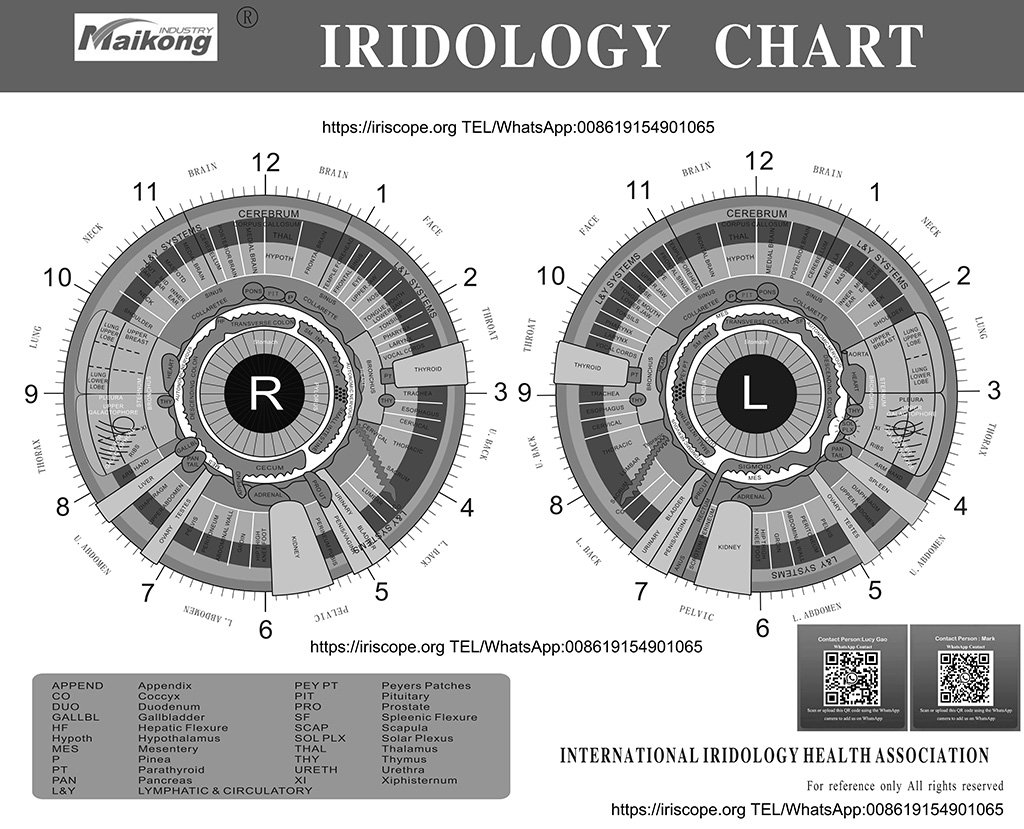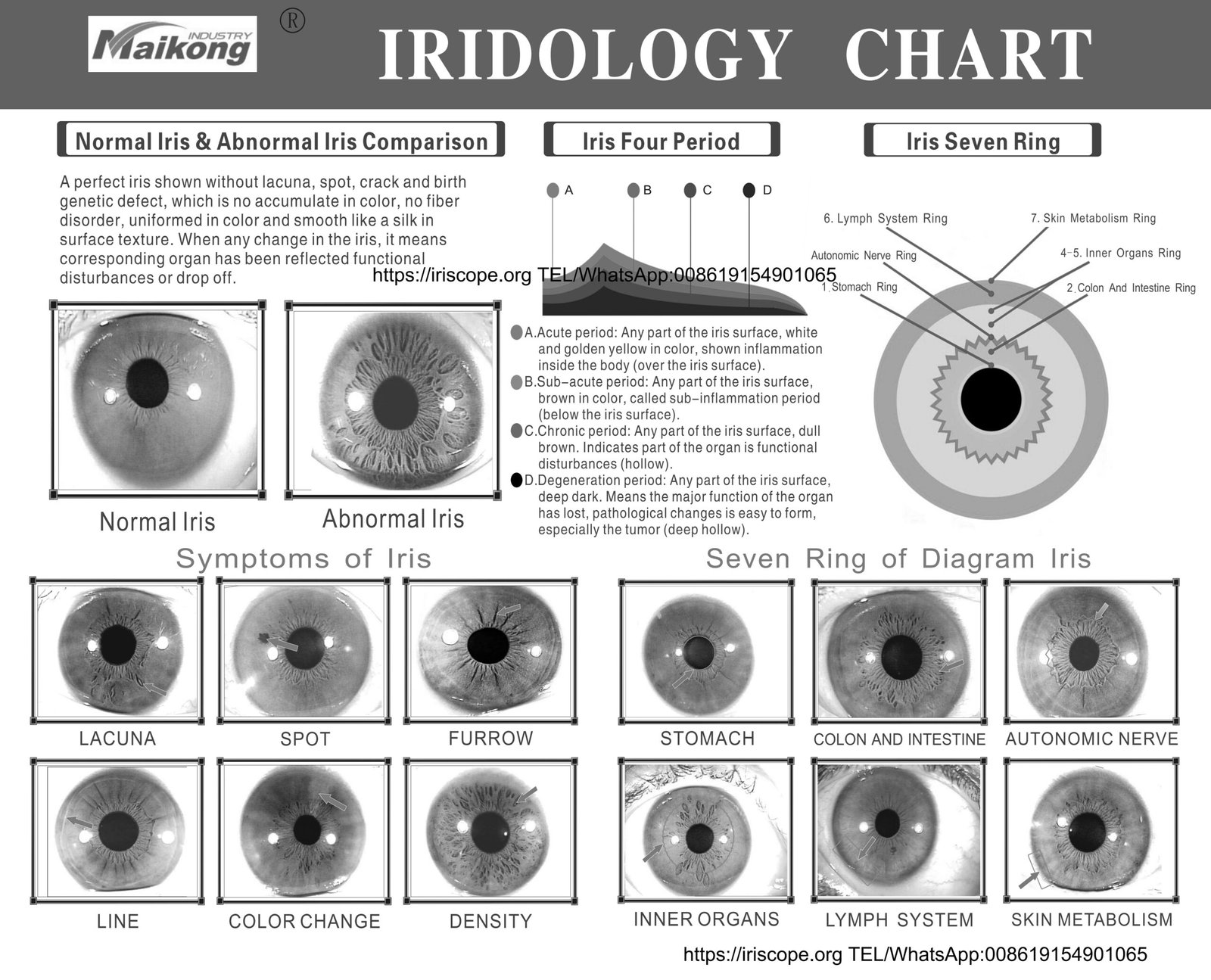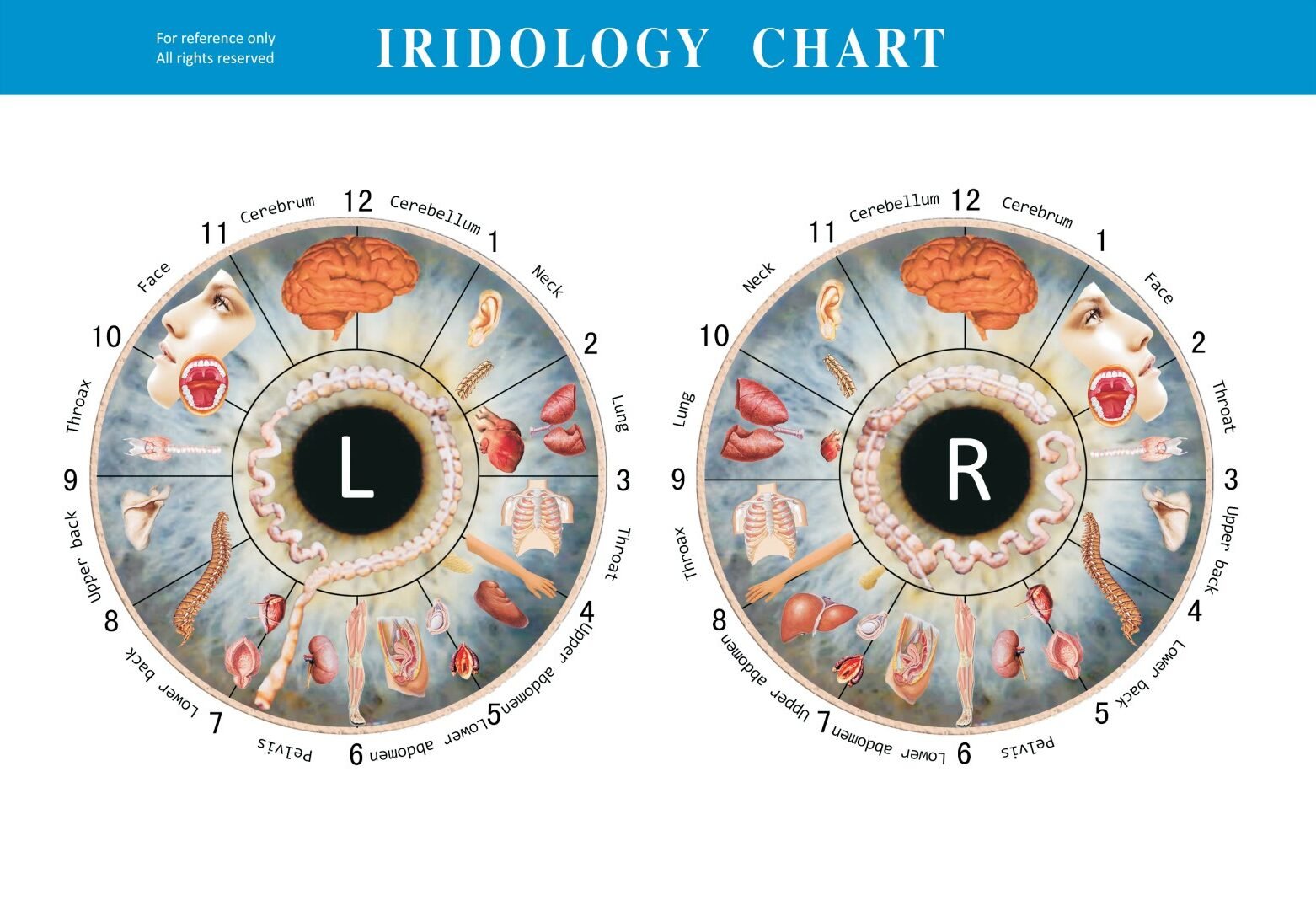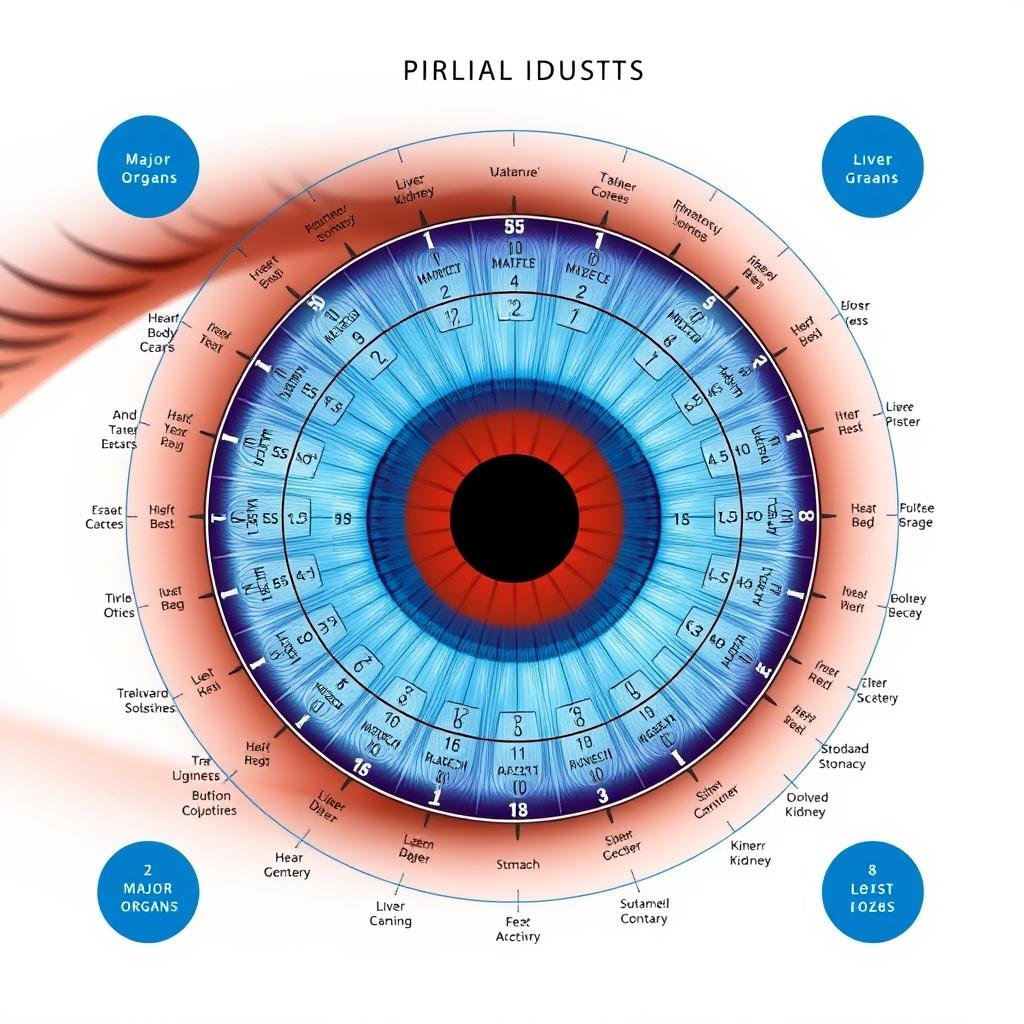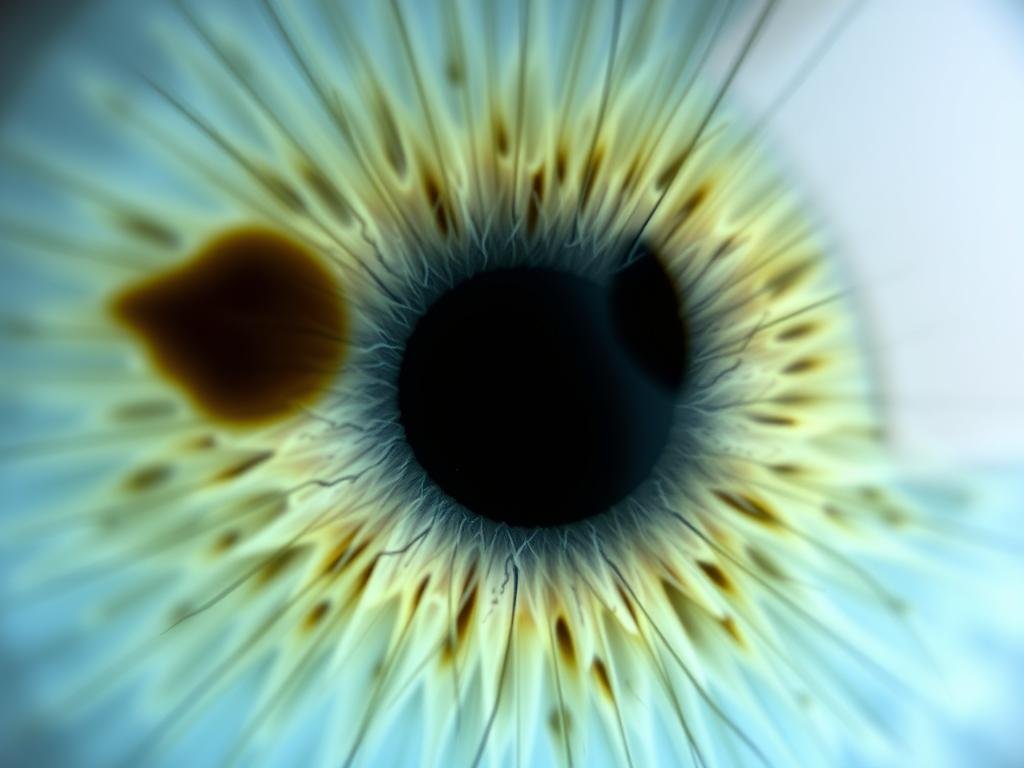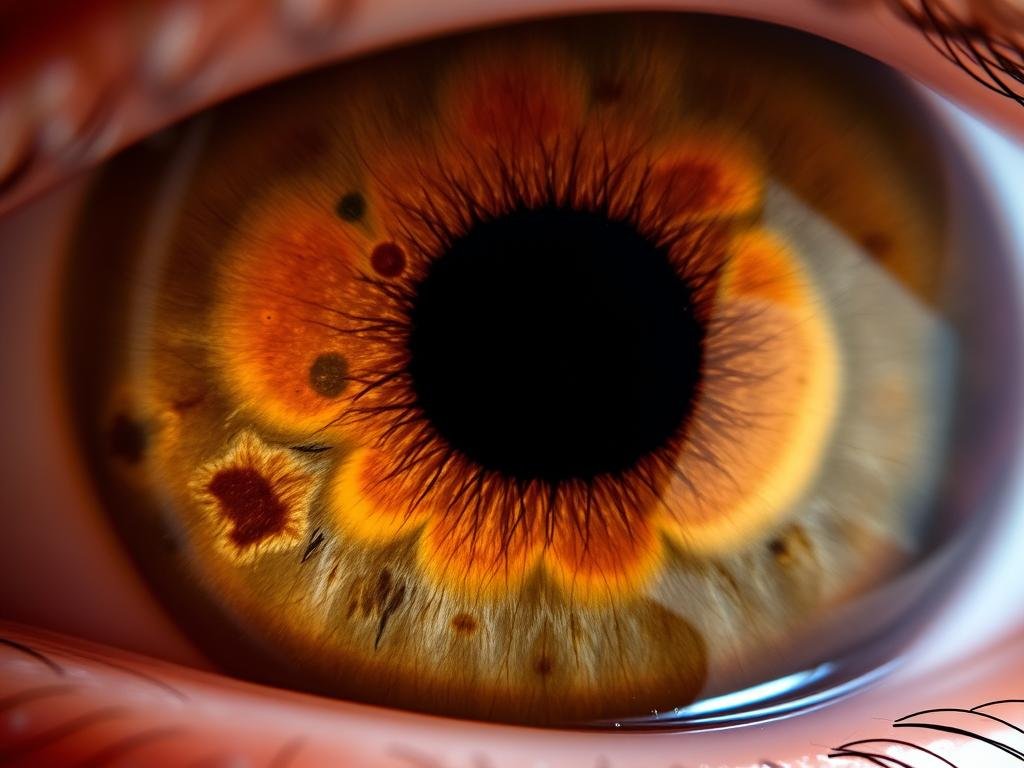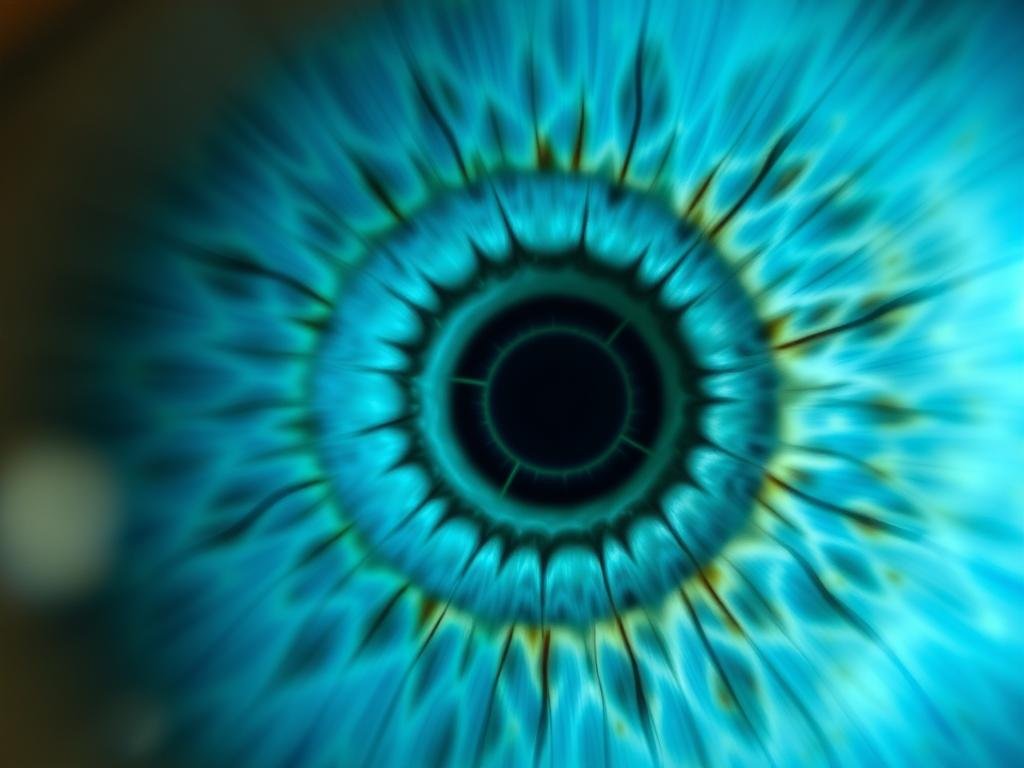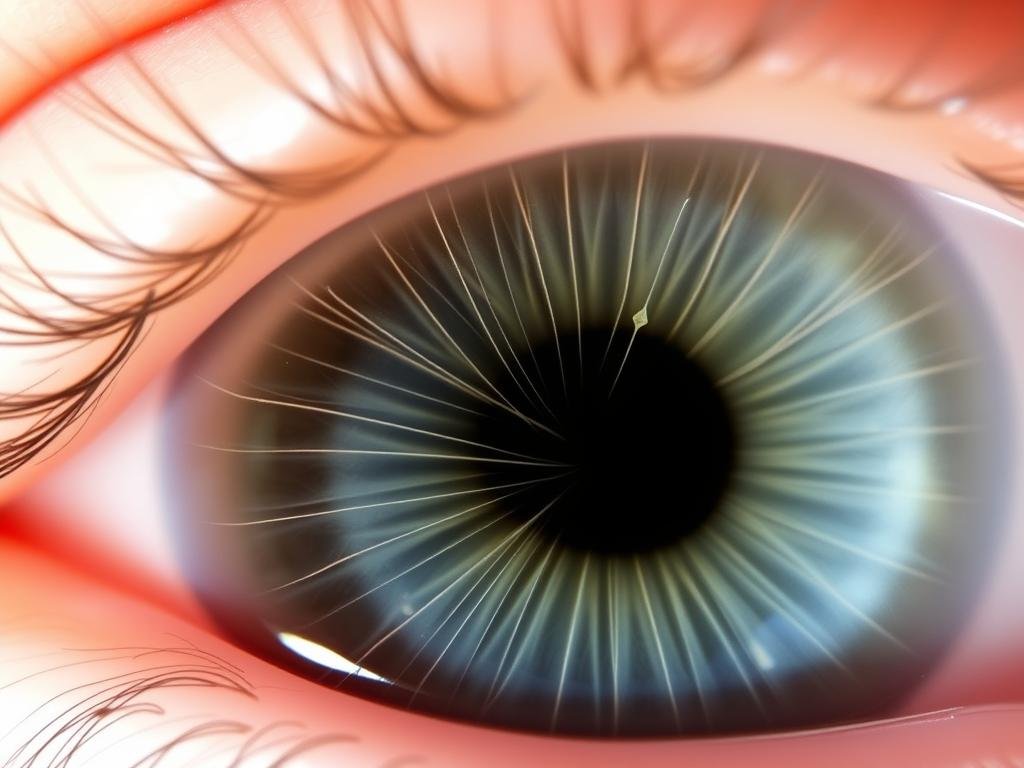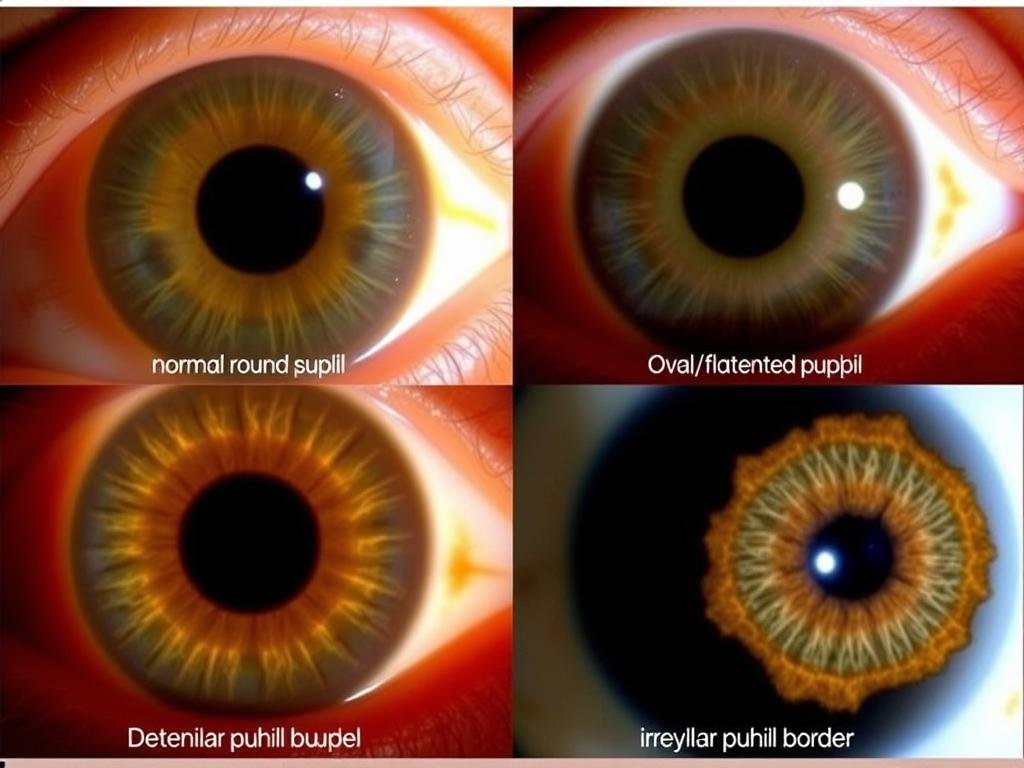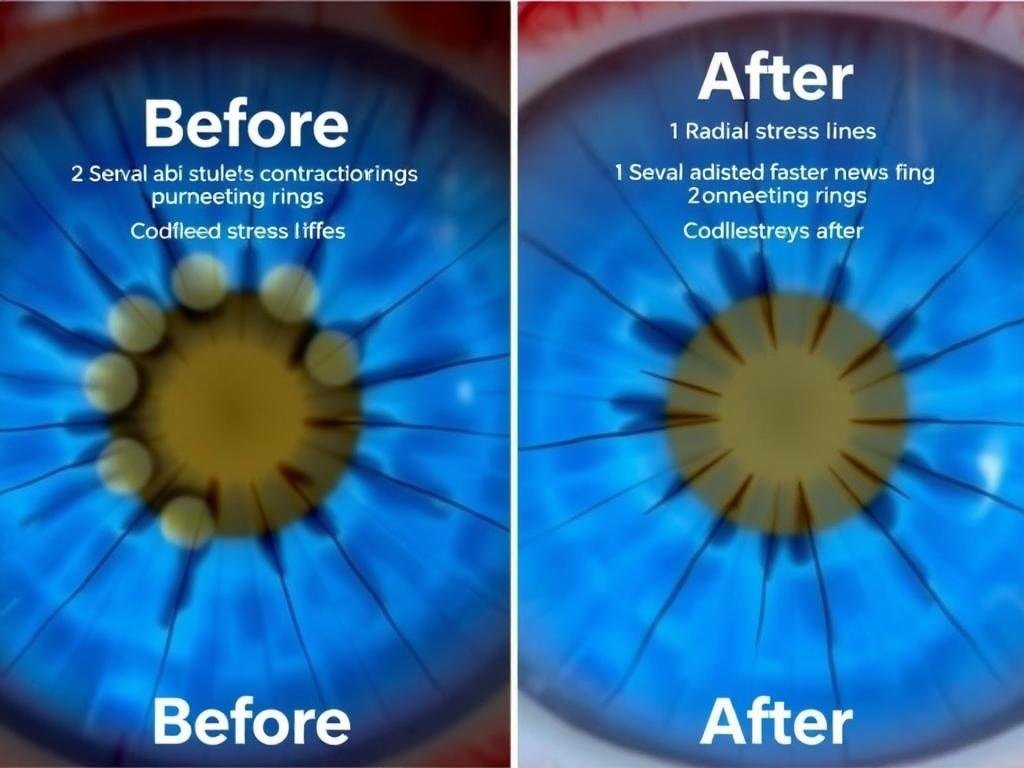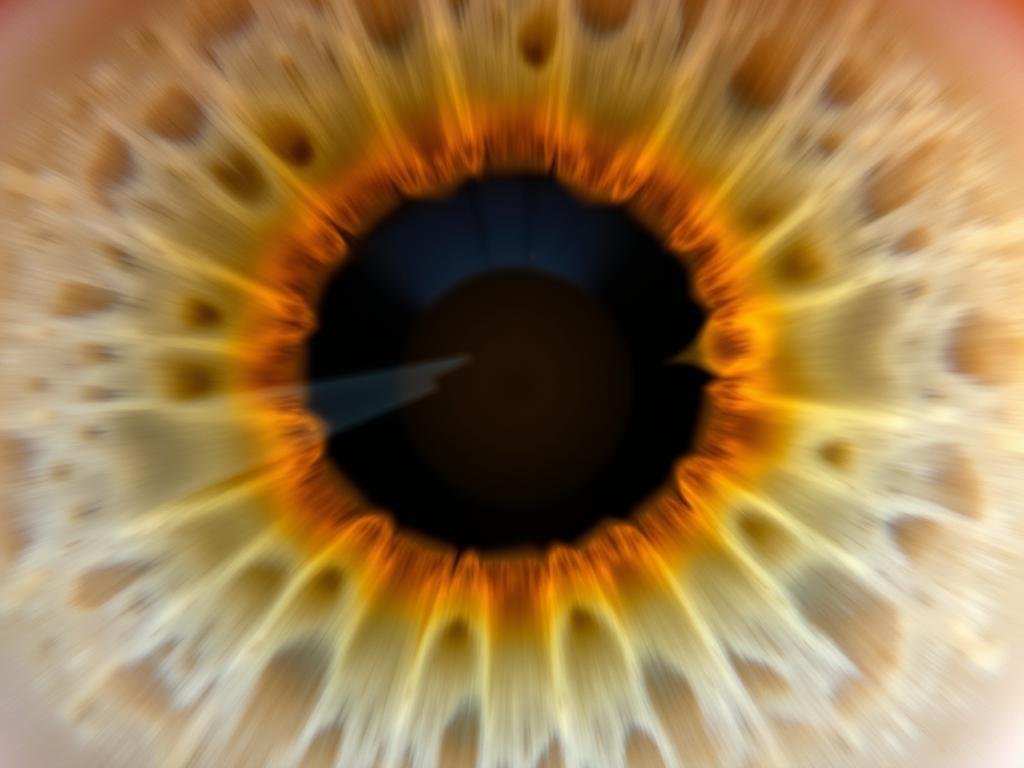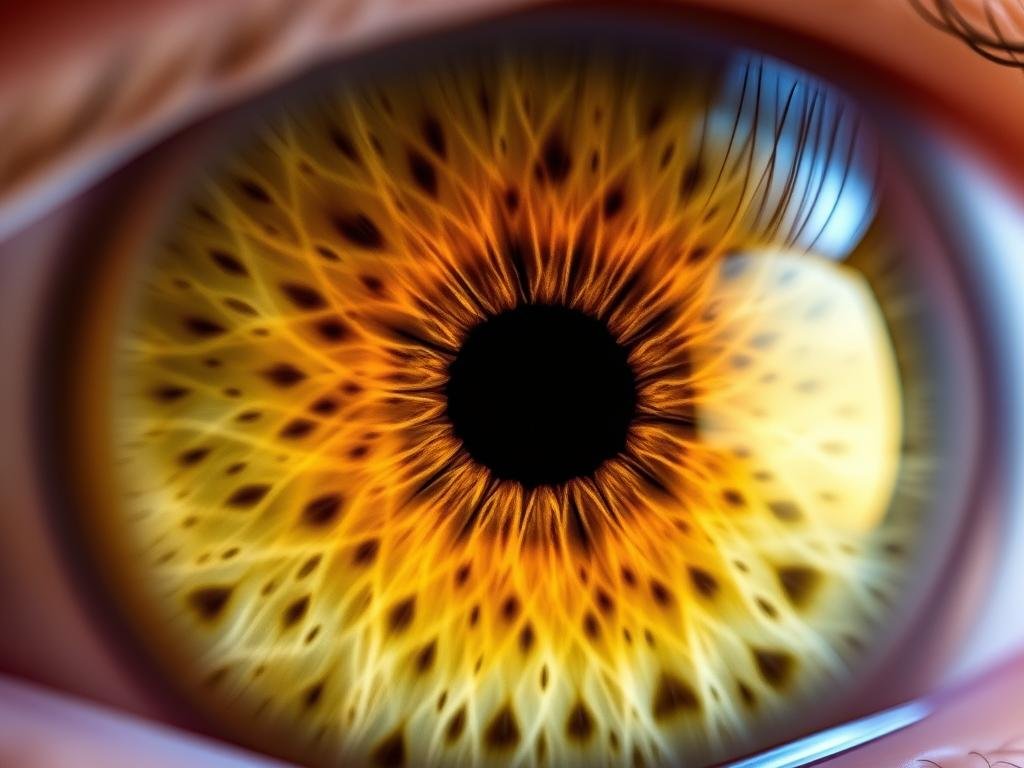Iridology is the study of the iris, the colored part of the eye, to determine information about a person’s overall health. Practitioners believe that specific patterns, colors, and markings in the iris can reveal potential health issues in corresponding areas of the body. While controversial in conventional medicine, iridology has a rich history and continues to be practiced by many alternative health practitioners worldwide.In this comprehensive guide, we’ll explore real-world iridology examples, examine case studies, and discuss both the potential applications and scientific perspectives on this alternative diagnostic approach.Le radici storiche dell'iridologia
An early iridology chart developed in the late 19th century
The origins of iridology are often attributed to Ignaz von Peczely, a Hungarian physician who, in 1881, noticed a dark mark in the iris of an owl with a broken leg. This observation led him to hypothesize a connection between iris markings and physical conditions. He later developed the first iridology chart mapping iris zones to different body systems.
In the 1950s, American chiropractor Bernard Jensen further developed iridologia by creating a comprehensive iris chart that is still widely used today. Jensen’s work emphasized the connection between iris signs and nutritional needs, promoting natural foods and detoxification to support health.
Today, iridologists use specialized equipment like cameras and microscopes to examine the iris in detail, comparing findings to standardized charts that divide the iris into approximately 60 zones, each corresponding to different parts of the human body.
The Language of the Iris
Iridologists believe that the iris functions as a detailed map of the body, with each section corresponding to specific organs and systems. Before diving into specific examples, it’s important to understand the basic “vocabulary” of iris analysis.


Modern iridology chart showing iris zones and their bodily correspondences
According to iridology theory, the left iris corresponds to the left side of the body, while the right iris reflects the right side. The iris is typically divided into concentric zones:
- IL Corona nervosa autonoma (or collarette) – separates the digestive zone from other body systems
- IL Zona pupillare – corresponds to digestive organs
- IL Zona ciliare – represents the rest of the body’s organs and systems
- IL Iris Border – relates to the skin, lymphatic system, and circulation
Iridologists examine various features including colors, patterns, and structural changes within these zones to identify potential health issues.
Deepen Your Understanding of Iris Analysis
Want to learn more about how to read the iris? Download our free basic iridology chart to better understand the examples discussed in this article.
Scarica grafico IRIDOLOGIA GRATUITO
Common Iris Markers Explained
Iridologists identify various markings in the iris that they believe correlate with specific health conditions. Here are some of the most common iris markers and their interpretations according to iridology practice:
1. Lacunae (Crypts)
Lacunae are oval or diamond-shaped areas in the iris that appear darker than surrounding tissue. They represent areas where iris fibers are either absent or sparse. According to iridology:
- Closed lacunae (dark with defined borders) may indicate chronic conditions in the corresponding organ
- Open lacunae (lighter with less defined borders) might suggest acute or developing issues
- The shape and location of lacunae are believed to provide additional diagnostic information
For example, a torpedo-shaped lacuna pushing against the autonomic nerve wreath in the breast area might be interpreted as a potential sign of breast tissue concerns.
2. Pigment Spots
Pigments are colored spots that appear in the iris and are classified into several types:
- Urosein (light yellow) – may indicate kidney stress or urinary system issues
- Rufin (reddish or brick red) – often associated with liver or pancreatic concerns
- Porphyrin (dark brown) – linked to liver disorders and hemoglobin degradation
- Melanin (brown or black) – may indicate degenerative conditions in corresponding organs
The location, color intensity, and number of pigment spots are all considered significant in iridology analysis.
3. Contraction Rings (Tetanic Rings)
Contraction rings appear as circular furrows concentric to the pupil. According to iridology:
- They may indicate nervous tension, stress, or anxiety
- Multiple rings suggest a stronger predisposition to spasmophilia (tendency toward muscle spasms)
- The location where rings begin and end may indicate which organs are most affected by stress
Practitioners often associate these rings with conditions like heart neurosis, panic attacks, and sleep disorders.
4. Radial Furrows (Radii Solaris)
Radial furrows appear as spoke-like lines extending outward from either the pupil or the autonomic nerve wreath. In iridology:
- Radii major (starting from pupil) may indicate stronger predisposition to nervous system issues
- Radii minor (starting from wreath) often relate to digestive system stress
- These markings are associated with headaches, mental fatigue, and concentration difficulties
5. Transversal Fibers
Transversal fibers run perpendicular to the normal radial pattern of iris fibers. According to iridology:
- They may indicate tissue damage or healing processes
- The direction and thickness of these fibers are considered significant
- Vascularized transversal fibers (those with visible blood vessels) may suggest more serious conditions
6. Pupil Abnormalities



The pupil itself provides valuable information in iridology:
- Pupil size differences between eyes (anisocoria) may indicate brain hemisphere imbalances
- Ovalization or flattening of the pupil might suggest nervous system issues or organ distress
- Pupil decentration (off-center position) could indicate the body “moving away” from a distressed area
- Irregular pupil borders may suggest specific organ weaknesses
Real-World Iridology Case Studies
While individual results vary, the following case studies illustrate how iridologists interpret iris signs in clinical practice. These examples demonstrate the application of iridology principles to real health situations.
Case Study 1: Stress Indicators
Patient Profile: 42-year-old female executive with complaints of chronic fatigue, insomnia, and digestive issues.
Osservazioni dell'iride: The iridologist noted multiple contraction rings throughout both irises, with particularly pronounced rings in the digestive zone. Several radii solaris extended from the pupil toward the frontal brain area. The autonomic nerve wreath appeared jagged and irregular, especially in areas corresponding to the digestive system.
Interpretazione: The iridologist suggested these markings indicated chronic stress affecting both the nervous and digestive systems. The contraction rings were interpreted as signs of nervous tension, while the radial furrows suggested potential stress-related headaches. The irregular nerve wreath in the digestive zone was associated with the patient’s reported digestive complaints.
Approccio: The practitioner recommended stress reduction techniques, dietary modifications, and specific herbs to support the nervous system. After six months, follow-up iris analysis showed reduced contraction rings and a more regular nerve wreath pattern, coinciding with the patient’s reported improvement in symptoms.
Case Study 2: Digestive System Correlations
Patient Profile: 35-year-old male with chronic bloating, irregular bowel movements, and occasional acid reflux.
Osservazioni dell'iride: The iridologist observed a salmon-pink ring (gastrin pigment) around the pupil in the stomach zone of both irises. Several small lacunae were noted in the intestinal area of the autonomic nerve wreath. The right iris showed yellowish discoloration (urosein pigment) in the liver zone.
Interpretazione: The gastrin pigment was interpreted as indicating stomach inflammation, possibly related to the reported acid reflux. The lacunae in the intestinal area were associated with potential weakness in intestinal function. The yellowish liver zone discoloration suggested possible liver stress affecting digestive function.
Approccio: The practitioner recommended dietary changes including elimination of potential trigger foods, digestive enzymes, and herbs to support liver function. After three months, the patient reported significant improvement in digestive symptoms, though iris changes were more subtle, with slight reduction in the gastrin pigment intensity.
Case Study 3: Constitutional Weaknesses
Patient Profile: 28-year-old female with family history of thyroid disorders, experiencing fatigue, weight fluctuations, and cold sensitivity.
Osservazioni dell'iride: The iridologist noted a distinctive “iodine lacuna” (a specific lacuna shape) in the thyroid zone of both irises. The patient’s iris structure showed a generally loose fiber arrangement throughout (indicating what iridologists call a “lymphatic constitution”). Several inherited lacunae patterns matched those seen in the patient’s mother’s irises.
Interpretazione: The iridologist suggested these markings indicated a constitutional weakness in the thyroid area, potentially inherited. The lymphatic constitution was interpreted as suggesting a tendency toward sluggish metabolism and potential immune system challenges.
Approccio: The practitioner recommended thyroid-supportive nutrients, immune-enhancing herbs, and regular moderate exercise. The patient was also referred for conventional thyroid testing, which revealed subclinical hypothyroidism. After six months of combined conventional and complementary approaches, the patient reported improved energy and stabilized weight, though the constitutional iris markings remained unchanged, as would be expected with inherited patterns.
What Research Says About Iridology
While iridology has many proponents worldwide, it’s important to acknowledge that the practice remains controversial in the scientific and medical communities. Several controlled studies have examined iridology’s diagnostic claims:
Skeptical Perspectives
- A 1999 study published in the Journal of Alternative and Complementary Medicine found that iridology’s efficacy was not supported by scientific evaluations
- A 2000 systematic review concluded that “iridology has shown to be of little benefit” and cautioned about potential misdiagnosis
- Critics point out that the iris structure remains largely stable throughout life, except for pigment changes in infancy, advanced age, or eye injury
Prospettive di supporto
- Some practitioners report clinical success using iridology as part of a holistic assessment
- Proponents argue that iridology is best used as a complementary tool rather than a standalone diagnostic method
- Some small-scale studies from Russia, Korea, and Italy have suggested potential correlations between certain iris signs and health conditions
Nota importante: Iridology should not be used as a substitute for proper medical diagnosis. If you have health concerns, always consult with qualified healthcare providers. Iridology may be considered as a complementary approach within a comprehensive health assessment.
The Future of Iridology
Despite scientific controversy, iridology continues to be practiced worldwide as part of complementary and alternative medicine. Some practitioners are working to standardize methods and integrate modern technology, such as digital iris imaging and analysis software, to improve consistency and potentially address some scientific criticisms.
Whether viewed as a valuable diagnostic tool or simply as an interesting historical approach to health assessment, iridology offers a unique perspective on the connection between the iris and overall health. The detailed examples and case studies presented here provide insight into how practitioners apply iridology principles, while acknowledging the importance of a balanced approach that includes conventional medical care.
As with many complementary health approaches, individuals interested in iridology should approach it with an open but critical mind, seeking practitioners who use it as part of a holistic assessment rather than as a replacement for conventional medical diagnosis.
Esplora ulteriormente l'iridologia
Interested in learning more about iridology examples and applications? Download our comprehensive guide including additional case studies, detailed iris charts, and a balanced discussion of research perspectives.
Ottieni la tua guida gratuita sull'iridologia


